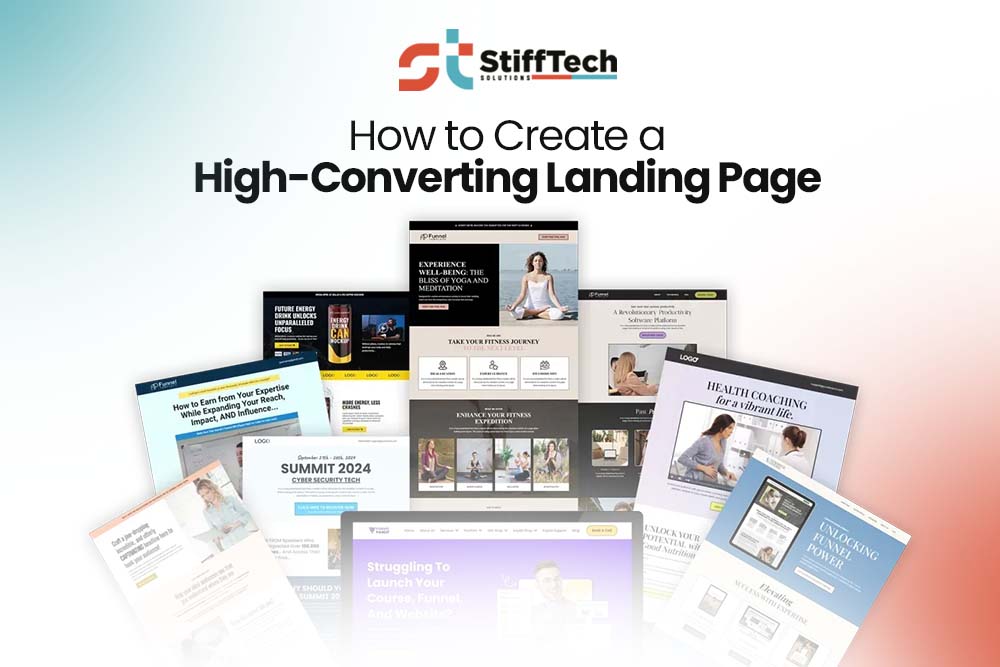
How to Use DeepSeek for Digital Marketing
The rise of AI has transformed the way businesses approach digital marketing. Tools like DeepSeek make it easier to analyze

A landing page is more than a standard webpage, it’s your brand’s introduction, your value proposition, and a powerful tool for driving conversions. You’re about to create a landing page. It’s crucial you get it right. You’ll need to understand your audience and set clear goals. But that’s just the start – what’s next will make all the difference.
Because your landing page’s success largely depends on how well it resonates with visitors, you need to understand who they are and what drives them. You’re creating this page for a specific group, so it’s crucial to know their needs, desires, and pain points. What problems do they face, and how can you solve them? You should research your target audience’s demographics, interests, and behaviors to get a clear picture. By doing so, you’ll be able to tailor your content and design to appeal to them. This understanding will help you build a connection with your visitors, increasing the chances of converting them into customers. You’ll create a page that speaks directly to them, addressing their concerns and needs.
As you develop your landing page, setting clear goals and objectives is crucial, since it determines what you want to achieve with your page. You need to define what a conversion means to you – is it a sale, a sign-up, or a download? You’ll use this information to guide your design and content decisions. By setting specific, measurable objectives, you can track your progress and make data-driven decisions. You should identify key performance indicators (KPIs) that align with your goals, such as click-through rates or conversion rates. This will help you evaluate your landing page’s effectiveness and make adjustments accordingly. Setting clear goals and objectives helps you stay focused on what matters most – driving conversions and achieving your desired outcomes. You’ll be able to optimize your page for better results.
You’ve defined what a conversion means to you, so now it’s time to craft a message that resonates with your target audience. You’re creating a unique value proposition that sets you apart from competitors. This message should clearly state the benefits of your product or service. It’s essential to focus on what makes you unique and how you can solve your audience’s problems.
You’ll want to identify your key differentiators and communicate them effectively. Consider what sets you apart and what value you bring to your customers. By doing so, you’ll create a compelling message that grabs attention and drives conversions. Keep it concise and straightforward, making it easy for your audience to understand your value proposition. This will help you build trust and increase the likelihood of conversion.
Your landing page’s layout is the first thing visitors will notice, so it’s crucial to make a strong visual impression. You’ll want to balance text and images to create a clean, intuitive design. Use a clear hierarchy of elements, with the most important information prominently displayed.
You’re aiming for a layout that’s easy to scan and navigate. Consider using a simple color scheme and plenty of white space to avoid overwhelming visitors. It’s also important to ensure your layout is responsive, so it looks great on all devices. By designing a visually appealing layout, you’ll keep visitors engaged and interested in learning more about your offer. This will help you build trust and increase conversions.
You’re now focusing on writing persuasive and concise content that converts visitors into customers. To achieve this, you’ll need to craft clear headlines that grab attention, identify key messages that resonate with your audience, and create a compelling call to action. By getting these elements right, you’ll be able to drive more conversions and boost the overall effectiveness of your landing page.
As you develop a landing page, clear headlines are crucial because they grab visitors’ attention and set the tone for the rest of the content. You’ll want to make sure your headlines are concise, yet descriptive. They should tell visitors what they can expect from your page. Keep your headlines short and to the point, focusing on the main benefit of your product or service. This will help you create a strong first impression and draw visitors in. By crafting clear headlines, you’ll be able to effectively communicate your message and keep visitors engaged. You’ll increase conversions too.
The call-to-action (CTA) is the most important element on your landing page because it leads the visitor to complete the desired action. Your CTA should be clear, bold, and direct. It must stand out visually and use action-oriented language that tells visitors exactly what to do next. Whether it’s “Get Started,” “Download Now,” or “Book Your Free Demo,” the CTA should describe the outcome and create urgency.
When designing a landing page, incorporating social proof and trust indicators can significantly boost conversions, as it helps establish credibility with potential customers. You’ll want to showcase customer testimonials, reviews, and ratings to demonstrate social proof. This can be in the form of quotes, photos, or videos. You’re also building trust by displaying trust indicators like security badges, certifications, and awards. These elements assure visitors that your business is legitimate and reputable. By including them, you’re more likely to convert visitors into customers. You should place these indicators strategically on your landing page to maximize their impact. This helps you build trust and credibility quickly, which is crucial for driving conversions and growing your business.
A clean, simple visual layout keeps visitors focused and reduces distractions. Using a minimal color palette, readable fonts, consistent spacing, and a well-organized structure ensures that your message is easy to digest. This is where applying the best UI/UX practices becomes essential, helping you enhance usability and improve overall flow. Adding high-quality visuals such as product images, demonstration videos, explainer illustrations, or relevant graphics strengthens credibility and makes the content more appealing. Authentic visuals always work better than generic stock imagery, as people connect with real representations of products or services.
You’re now ready to do A/B testing for marketing of your landing page to see what works best. You’ll analyze the data to understand how different elements impact conversion rates, and you’ll use that info to make informed decisions. By comparing the performance of different test variants, you’ll be able to identify what’s driving conversions and what’s not, allowing you to optimize your page for better results.
Conducting A/B testing and analysis is crucial for optimizing your landing page’s conversion rates. You’ll test different versions of your page to see what works best. This helps you identify which elements drive conversions. You’re looking for statistically significant results to inform your design decisions. By analyzing the data, you can refine your page’s layout, content, and calls-to-action. This process isn’t a one-time task – it’s ongoing. You’ll continually test and analyze to ensure your page remains optimized. As you iterate, you’ll boost your conversion rates and improve your landing page’s overall performance.
As you develop your landing page, incorporating search engine optimization (SEO) strategies is crucial to increase its visibility and drive more conversions. You’ll want to conduct keyword research to identify relevant terms and phrases your target audience uses. This helps you optimize your page’s content, meta tags, and headlines. You’re also optimizing your images by adding alt tags and descriptive text. Don’t forget to make your page mobile-friendly, as this is now a key ranking factor. Keep your SEO efforts focused and targeted to maximize your landing page’s impact.
Creating a successful landing page requires thoughtful planning, persuasive writing, strategic design, and ongoing optimization. By focusing on clarity, powerful messaging, strong visuals, trust-building elements, and smooth user experience, you can apply the most effective high-converting landing page tips and follow proven landing page best practices. With this complete landing page design guide, you now understand how to create a landing page that not only attracts visitors but also converts them into loyal customers. When each component works together, your landing page becomes a powerful tool for maximizing engagement and boosting your conversion rate optimization strategy.
You’ll find average conversion rates range from 2-5%, but you’re aiming higher, aren’t you, and you’ll optimize your page to beat that, won’t you, by testing and refining it constantly.
To create a high-converting landing page, focus on a strong headline, clean design, compelling visuals, benefit-driven content, trust-building elements, and a clear call-to-action. Ensuring fast loading speed, mobile optimization, and continuous testing further improves performance.
A persuasive headline, clear subheadline, engaging visuals, benefit-focused descriptions, social proof, a strong CTA, short forms, and a clean layout are essential elements. Each component should work together to guide visitors toward completing the desired action.

The rise of AI has transformed the way businesses approach digital marketing. Tools like DeepSeek make it easier to analyze

You’re about to create a content marketing strategy. It’s 2025, and you need a solid plan to drive leads. The

You’re about to launch a marketing campaign. To ensure it’s effective, you’ll want to run an A/B test. You’ll need